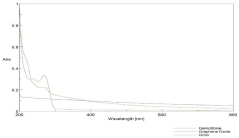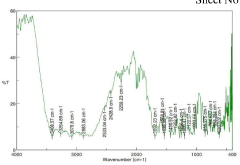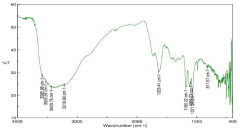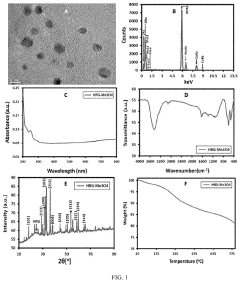Discover Graphene Oxide: A Catalyst in Biomedical Applications
Graphene Oxide Evolution
Graphene oxide has undergone a remarkable evolution since its initial discovery, marking significant milestones in the field of nanomaterials and biomedical applications. The journey of graphene oxide began with the groundbreaking work on graphene by Andre Geim and Konstantin Novoselov in 2004, which later earned them the Nobel Prize in Physics in 2010.
The early stages of graphene oxide development focused primarily on its synthesis and characterization. The Hummers method, developed in 1958, became the foundation for large-scale production of graphene oxide. This method involves the oxidation of graphite using strong oxidizing agents, resulting in the formation of graphene oxide sheets. Over time, researchers refined this process, leading to the development of improved and safer synthesis techniques, such as the modified Hummers method and the Tour method.
As the synthesis processes improved, researchers began to explore the unique properties of graphene oxide. Its large surface area, excellent mechanical strength, and high electrical conductivity made it an attractive material for various applications. In the biomedical field, the oxygen-containing functional groups on graphene oxide's surface proved to be particularly advantageous, allowing for easy functionalization and biocompatibility.
The mid-2010s saw a surge in research focused on graphene oxide's potential in drug delivery systems. Scientists discovered that graphene oxide could effectively load and release various therapeutic agents, including small molecule drugs, proteins, and genes. This breakthrough opened up new possibilities for targeted drug delivery and controlled release mechanisms.
Concurrently, graphene oxide's potential in biosensing applications gained attention. Researchers developed highly sensitive and selective biosensors using graphene oxide as a platform, enabling the detection of various biomolecules and pathogens with unprecedented accuracy and speed.
In recent years, the focus has shifted towards exploring graphene oxide's role in tissue engineering and regenerative medicine. Studies have demonstrated its ability to promote cell adhesion, proliferation, and differentiation, making it a promising material for scaffolds in tissue engineering applications.
The latest developments in graphene oxide research have centered on its potential in cancer therapy. Scientists are investigating its use in photothermal therapy, where graphene oxide's ability to absorb near-infrared light is harnessed to selectively destroy cancer cells. Additionally, its potential as a radiosensitizer in cancer radiotherapy is being explored, showing promising results in enhancing the effectiveness of radiation treatments.
As we look to the future, the evolution of graphene oxide in biomedical applications continues to accelerate. Researchers are now focusing on addressing challenges such as long-term biocompatibility, controlled biodegradation, and scalable production methods. These efforts aim to bridge the gap between laboratory research and clinical applications, paving the way for graphene oxide-based therapies and diagnostic tools to revolutionize healthcare in the coming years.
Biomedical Market Demand
The biomedical market for graphene oxide (GO) applications is experiencing rapid growth, driven by the material's unique properties and versatility in various medical fields. The global graphene market, including GO, is projected to reach significant value in the coming years, with the biomedical sector playing a crucial role in this expansion.
In the pharmaceutical industry, GO shows promise in drug delivery systems due to its large surface area and ability to carry various therapeutic agents. This has led to increased research and development efforts in targeted drug delivery, potentially revolutionizing cancer treatments and other therapies. The demand for more efficient and precise drug delivery methods continues to drive investment in GO-based solutions.
The biosensing and diagnostic sector represents another area of substantial market demand for GO. The material's excellent electrical conductivity and high sensitivity make it ideal for developing advanced biosensors capable of detecting various biomarkers, pathogens, and molecules at ultra-low concentrations. This capability is particularly valuable in early disease detection and personalized medicine applications, areas that are seeing increased focus and investment in healthcare systems worldwide.
Tissue engineering and regenerative medicine also present significant market opportunities for GO. The material's biocompatibility and ability to promote cell growth and differentiation have led to its exploration in scaffolds for tissue regeneration, wound healing, and bone tissue engineering. As the aging population grows and the demand for advanced regenerative therapies increases, the market for GO-based biomaterials is expected to expand considerably.
In the field of antimicrobial applications, GO has shown potential in developing new antibacterial coatings and materials. This is particularly relevant in healthcare settings, where the need for effective antimicrobial surfaces is critical in preventing hospital-acquired infections. The growing concern over antibiotic resistance further amplifies the demand for alternative antimicrobial solutions, positioning GO as a promising candidate in this market segment.
The imaging and theranostics sector also demonstrates significant market potential for GO. Its ability to act as a contrast agent in various imaging modalities, combined with its potential for simultaneous diagnosis and therapy (theranostics), opens up new avenues in personalized medicine and targeted therapies. This aligns with the broader trend towards more precise and individualized healthcare approaches.
As research continues to uncover new biomedical applications for GO, the market demand is expected to diversify further. However, challenges such as scalability, cost-effectiveness, and regulatory approval processes need to be addressed to fully realize the market potential of GO in biomedical applications. Despite these challenges, the unique properties of GO and its demonstrated versatility in addressing various biomedical needs position it as a key material in the future of healthcare innovation and technology.
Technical Challenges
Despite the promising potential of graphene oxide in biomedical applications, several technical challenges hinder its widespread adoption and implementation. One of the primary concerns is the lack of standardization in the production and characterization of graphene oxide. The variability in synthesis methods leads to inconsistent quality and properties, making it difficult to achieve reproducible results across different research groups and applications.
Another significant challenge is the potential toxicity of graphene oxide. While many studies have shown its biocompatibility, there are conflicting reports on its long-term effects on living organisms. The interaction between graphene oxide and biological systems is complex and not fully understood, raising concerns about its safety for in vivo applications. This uncertainty necessitates extensive toxicological studies and risk assessments before graphene oxide can be widely used in clinical settings.
The controlled functionalization of graphene oxide surfaces presents another technical hurdle. While the abundance of oxygen-containing functional groups on graphene oxide provides opportunities for modification, achieving precise and uniform functionalization remains challenging. This is crucial for tailoring graphene oxide's properties for specific biomedical applications, such as drug delivery or biosensing.
Scalability and cost-effectiveness in the production of high-quality graphene oxide pose additional challenges. Current methods for large-scale production often result in lower quality materials or increased costs, limiting the commercial viability of graphene oxide-based biomedical products. Developing efficient and economical production techniques that maintain the desired properties of graphene oxide is essential for its widespread adoption in the biomedical industry.
The stability of graphene oxide in biological environments is another area of concern. Its tendency to aggregate in physiological conditions can affect its performance and potentially lead to undesired biological responses. Developing strategies to enhance the colloidal stability of graphene oxide without compromising its unique properties is crucial for its successful application in biomedical fields.
Lastly, the regulatory landscape for graphene oxide-based biomedical products remains uncertain. The novel nature of this material and its diverse applications present challenges in establishing appropriate regulatory frameworks. This uncertainty can slow down the translation of research findings into clinical applications, as extensive safety and efficacy data are required to meet regulatory standards.
Addressing these technical challenges requires interdisciplinary collaboration among materials scientists, biomedical engineers, toxicologists, and regulatory experts. Overcoming these hurdles will be crucial in realizing the full potential of graphene oxide as a catalyst in biomedical applications, paving the way for innovative therapies and diagnostic tools.
Current GO Solutions
01 Synthesis and production methods of graphene oxide
Various methods for synthesizing and producing graphene oxide are described, including chemical exfoliation, oxidation of graphite, and reduction processes. These techniques aim to create high-quality graphene oxide with controlled properties for different applications.- Synthesis and production methods of graphene oxide: Various methods for synthesizing and producing graphene oxide are described, including chemical exfoliation, oxidation of graphite, and reduction processes. These techniques aim to create high-quality graphene oxide with controlled properties for different applications.
- Applications of graphene oxide in electronics and energy storage: Graphene oxide is utilized in electronic devices and energy storage systems due to its unique properties. It is incorporated into batteries, supercapacitors, and other electronic components to enhance performance and efficiency.
- Functionalization and modification of graphene oxide: Techniques for functionalizing and modifying graphene oxide are explored to tailor its properties for specific applications. This includes chemical treatments, doping, and surface modifications to enhance its performance in various fields.
- Graphene oxide-based composites and materials: The development of graphene oxide-based composites and materials is described, combining graphene oxide with other substances to create novel materials with enhanced properties for applications in areas such as water treatment, sensors, and structural materials.
- Characterization and analysis techniques for graphene oxide: Various methods and techniques for characterizing and analyzing graphene oxide are presented. These include spectroscopic, microscopic, and other analytical approaches to determine the structure, composition, and properties of graphene oxide materials.
02 Applications of graphene oxide in electronics and energy storage
Graphene oxide is utilized in electronic devices and energy storage systems due to its unique properties. It is incorporated into batteries, supercapacitors, and other electronic components to enhance performance and efficiency.Expand Specific Solutions03 Functionalization and modification of graphene oxide
Techniques for functionalizing and modifying graphene oxide are explored to tailor its properties for specific applications. This includes chemical treatments, doping, and surface modifications to enhance its performance in various fields.Expand Specific Solutions04 Graphene oxide-based composites and materials
The development of graphene oxide-based composites and materials is described, combining graphene oxide with other substances to create novel materials with enhanced properties for applications in areas such as structural materials, coatings, and filters.Expand Specific Solutions05 Characterization and analysis techniques for graphene oxide
Various methods and techniques for characterizing and analyzing graphene oxide are presented, including spectroscopic, microscopic, and electrochemical approaches. These techniques help in understanding the structure, properties, and quality of graphene oxide samples.Expand Specific Solutions
Key Industry Players
The graphene oxide market in biomedical applications is in a growth phase, with increasing research and commercial interest. The global market size for graphene-based products is projected to expand significantly in the coming years. Technologically, graphene oxide is advancing rapidly, with various institutions and companies at different stages of development. Leading research entities like Centre National de la Recherche Scientifique, Northwestern University, and Tsinghua University are pushing the boundaries of graphene oxide applications. Companies such as SABIC Global Technologies BV and Lumileds Holding BV are exploring commercial possibilities, while universities like Zhejiang University and The University of Manchester are contributing to fundamental research, indicating a diverse and competitive landscape in this emerging field.
Centre National de la Recherche Scientifique
Northwestern University
Core GO Innovations
- Development of a graphene oxide loaded nanocarrier for targeted delivery of Gemcitabine, synthesized using a modified Hummer's method, which enables controlled loading and release of the drug through functionalization with EDC, enhancing biocompatibility and physiological stability.
- Hybrid nanoparticles comprising manganese oxide and highly reduced graphene oxide (HRG-Mn3O4) are synthesized for use in photodynamic therapy and MRI imaging, offering a nontoxic and biocompatible solution for cancer treatment and diagnosis by activating photosensitizers at specific wavelengths and enhancing magnetic resonance signals.
Regulatory Landscape
The regulatory landscape surrounding graphene oxide in biomedical applications is complex and evolving. As this nanomaterial gains prominence in medical research and potential clinical use, regulatory bodies worldwide are working to establish comprehensive frameworks to ensure its safe and effective implementation.
In the United States, the Food and Drug Administration (FDA) plays a crucial role in regulating graphene oxide-based medical products. The FDA's approach to nanotechnology, including graphene oxide, is guided by its Nanotechnology Task Force. This task force assesses the potential risks and benefits of nanomaterials in medical applications, considering factors such as toxicity, biocompatibility, and long-term effects.
The European Medicines Agency (EMA) has also been proactive in addressing the regulatory challenges posed by nanomaterials like graphene oxide. The EMA's approach focuses on risk assessment and management, emphasizing the need for thorough characterization of nanomaterials used in medical products. This includes evaluating their physical and chemical properties, as well as their potential interactions with biological systems.
In Asia, countries like China and Japan have been developing their own regulatory frameworks for nanomaterials in biomedical applications. China's National Medical Products Administration (NMPA) has issued guidelines for the evaluation of nanomedicine products, which include considerations for graphene oxide-based materials. Similarly, Japan's Pharmaceuticals and Medical Devices Agency (PMDA) has been working on establishing regulatory pathways for innovative materials in medical devices and pharmaceuticals.
International organizations, such as the International Organization for Standardization (ISO), have been instrumental in developing standards for the characterization and safety assessment of nanomaterials. These standards provide a common language and methodology for researchers, manufacturers, and regulatory bodies to evaluate graphene oxide and other nanomaterials consistently across different jurisdictions.
One of the key challenges in regulating graphene oxide is the lack of long-term safety data. Regulatory bodies are increasingly requiring manufacturers to conduct thorough toxicological studies and provide comprehensive safety profiles before approving graphene oxide-based products for clinical use. This cautious approach aims to balance innovation with patient safety.
As research in graphene oxide applications continues to advance, regulatory frameworks are expected to evolve. There is a growing emphasis on harmonizing regulations across different regions to facilitate global development and commercialization of graphene oxide-based medical products. This harmonization effort aims to streamline the approval process while maintaining rigorous safety standards.
Toxicity Considerations
While graphene oxide (GO) has shown immense potential in biomedical applications, its toxicity considerations are of paramount importance. The unique physicochemical properties that make GO attractive for medical use also raise concerns about its potential adverse effects on biological systems.
GO's high surface area and reactive functional groups can interact with cellular components, potentially leading to oxidative stress and inflammation. Studies have shown that GO can accumulate in various organs, including the lungs, liver, and spleen, with the potential for long-term effects. The size, shape, and surface chemistry of GO particles play crucial roles in determining their toxicity profile.
Inhalation toxicity is a primary concern, especially for workers involved in GO production and handling. Pulmonary exposure to GO has been associated with lung inflammation and fibrosis in animal studies. The ability of GO to cross biological barriers, including the blood-brain barrier, raises additional concerns about its potential neurotoxicity.
Genotoxicity and reproductive toxicity are areas that require further investigation. Some studies have suggested that GO can induce DNA damage and affect embryonic development, but the results are not conclusive and dose-dependent effects need to be carefully evaluated.
The biodegradability and clearance of GO from the body are critical factors in assessing its long-term safety. While some research indicates that GO can be degraded by certain enzymes, the rate and extent of this process in vivo remain unclear. The potential for GO to persist in tissues and cause chronic effects necessitates thorough long-term studies.
Efforts to mitigate GO toxicity have focused on surface modifications and functionalization strategies. By altering the surface properties of GO, researchers aim to reduce its reactivity and improve its biocompatibility. However, these modifications may also affect the desired functional properties of GO, requiring a delicate balance between safety and efficacy.
Standardization of toxicity testing protocols for GO is essential to ensure consistent and comparable results across studies. The development of in vitro models that accurately predict in vivo toxicity is an ongoing challenge in the field. Additionally, the establishment of regulatory guidelines specific to nanomaterials like GO is crucial for their safe implementation in biomedical applications.







